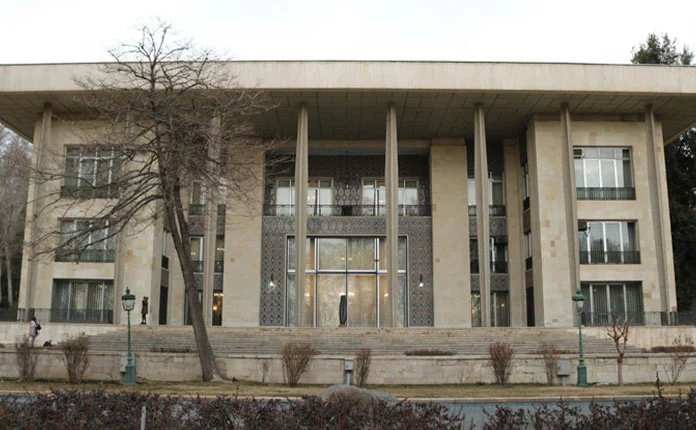The Niavaran historical and cultural complex, with its beautiful and impressive mansions, is an attractive and captivating place to spend a full day of entertainment and one of the best places to visit in Tehran. The mansions exhibit different architectural styles and are very photogenic, enticing every tourist to take photos, making the passage of time intangible for its visitors. Join OverIran to visit Niavaran Palace with complete knowledge.
The total number of palaces and mansions built in this garden is 5, including main and secondary buildings. The time of their construction spans different historical periods from the Qajar period to the second Pahlavi period. Due to its unique natural environment and historical buildings, this complex was included in the list of national monuments in 1377.
Niavaran Palace, Sahibqaraniyeh Palace, Ahmadshahi Kush, Jahannama Palace, the dedicated library, car museum, and several other buildings constitute the cultural complex of Niavaran. Iran is the earth. Stay with Alibaba Tourism Magazine today to get to know Niavaran Palace like the palm of your hand.
Important information
- location on google map
- Visiting hours: Spring and summer: 9 am to 7 pm (ticket sales until 5 pm). Autumn and winter: 8 am to 5 pm (ticket sales until 4 pm).
History and Background of Niavaran Palace
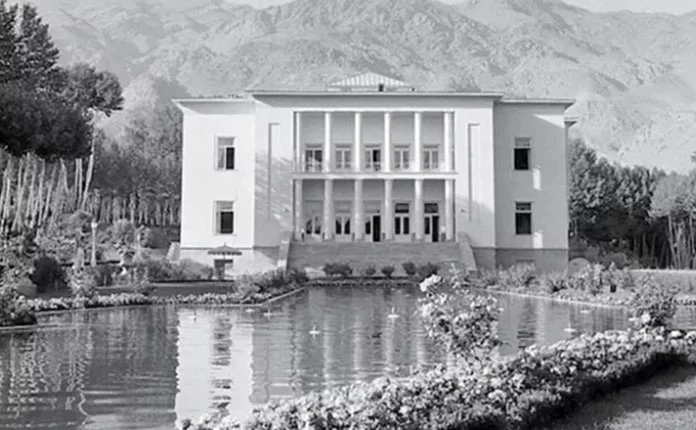
If you take a look at the history of Niavaran Palace, you will see that it witnessed two periods of Iranian kings’ rule. Due to everything it has gone through over the years, Niavaran has become one of the most important sights in the country’s political field in the last two centuries. Perhaps, by delving a bit more into the history of Niavaran Palace and its ups and downs, you will become more interested in this spectacular palace.
Qajar Era: The Qajar era marks the beginning of Niavaran Palace. Fath Ali Shah, the second king of the Qajar dynasty, ordered the construction of a garden as the king’s summer residence in an area with good weather outside Tehran. Niavaran Palace is one of those gardens, built next to a village called (Gorde Be) or (Gorde Ve), near a reed field. For this reason, they named it Bagh Niavaran, later known simply as Niavaran.
Pahlavi Era: Niavaran Palace was forgotten during the Pahlavi era until, during the reign of Mohammad Reza Pahlavi, a number of small buildings were demolished to construct the Niavaran Palace in its famous shape today. The construction began in 1337, and after about 9 years, it was ready for operation. The new palace, a two-story mansion with a mezzanine, was built in a modern style. Initially intended as a place for receiving foreign guests, it eventually became the residence of the Shah and his family.
Note: If you are interested in palaces and historical monuments, be sure to visit SaadAbad Palace.
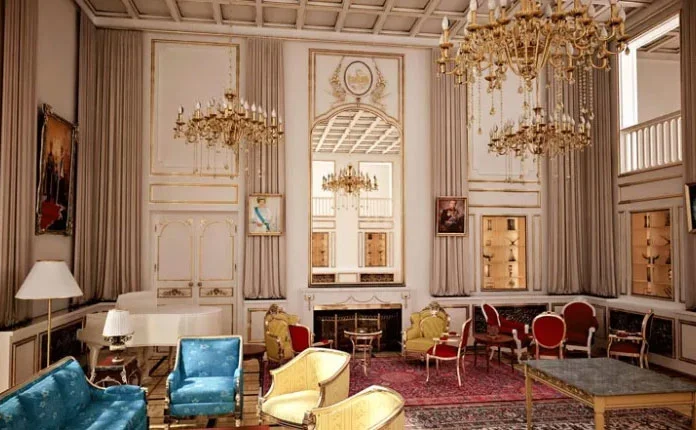
After the Revolution: After the Islamic Revolution, Niavaran Palace was captured and handed over to the Ministry of Culture and Islamic Guidance in 1360. Five years later, the doors of Niavaran Palace were opened to everyone as a museum. In the subsequent years, Jahannama Museum (in 1376), Sahibqraniyeh Palace (in 1377), Ahmadshahi Kushk Museum (in 1379), Private Library Museum (in 1383), Bagh of Inscriptions (in 1387), and the dedicated car museum (in 1391) were opened.
It is interesting to note that during this period, Niavaran Palace was closed for six years in 2002 for restoration purposes. Experts in the restoration of ancient works repaired plasterings, mirrors, replaced electrical systems, repaired pavements and floors of various spaces, created an electronic protection system, reset the movable ceiling, and restored furniture, curtains, and palace objects according to standards. Finally, this landmark reopened to the public in 2008.
Niavaran Palace Architecture
Perhaps it can be said with certainty that Niavaran Palace will attract you at first glance due to its simple yet modern architecture. The exterior of the palace is made of bricks with delicate pea-colored patterns, and the tall white columns of the building enhance its splendor and endurance. The columns continue to the balconies of the second-floor rooms and end just below the ceiling. Each of the rooms on the second floor has its own balcony with a view of the beautiful garden of Niavaran.
The designer of Niavaran Palace, Engineer Mohsen Foroughi, is one of the pioneers of modern architecture in Iran, having completed his education in prestigious French universities. This building was constructed by Map Company and Abdulaziz Farmanfarmaian Consulting Engineers and Associates, who supervised the work as consulting engineers.
In general, the interior of the palace is simple, advanced, and at the same time modern, so that anyone with any taste will be interested in it. Each of the spectacular decorations of the palace was entrusted to the most famous artists of the time; plastering was done by Master Abdolahi, mirror works by Master Ali Asghar, and exterior tiling by Master Ali Asghar, each of which is unique in its own way. Niavaran Palace has a quadrangular structure consisting of two floors and one-half floor.
Interior Design and Decoration of Niavaran Palace
The ground floor of Niavaran Palace is a large hall with various rooms around it, intended to receive guests. The interior space of the main palace’s ground floor consists of different rooms. Rooms like the mirror hall, private cinema, dining room, reception room, etc., are all bright with tall and large windows. The decoration and furniture of the palace are the responsibility of a French company. The interior design of the palace is based on modern ideas in Iranian archaeology, and the decorations are a combination of authentic Iranian art before and after Islam.
Between the stairs connecting the first floor to the second floor, there is a mezzanine that served as a workspace. The second floor of Niavaran Palace is a duplex overlooking the first floor, yet it provides a more private space. The walls of this floor are adorned with precious works of art and valuable gifts from other countries. In general, it can be said that the valuable paintings in Niavaran Palace constitute a complete treasure of Iranian and world art.
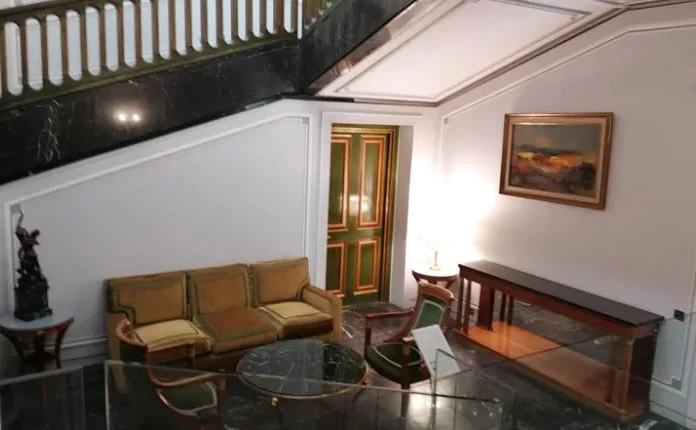
Now we come to the most unique architectural feature of Niavaran Palace. Up until now, the structure of the building was similar to other royal palaces, but what sets Niavaran apart and gives it a distinctive touch is the unusual structure of its roof. The roof of the second floor is a type of movable aluminum mesh that allows the sky into the palace on sunny days. Engineer Mohsen Foroughi, an expert in natural light in architecture, designed the opening roof of Niavaran Palace to not only provide natural light to the interior space but also enhance the building’s beauty and create natural ventilation.
Niavaran Palace: The Main Residence of Mohammad Reza Pahlavi (king) and His Family
Pass through the massive entrance columns and enter the palace. The black granite floor under your feet is the first thing that catches your attention. Niavaran Palace, covering an area of 9000 square meters, consists of a two-story building, a mezzanine, and a basement. From this point onward, everything will be spectacular, so keep your eyes and ears open as we guide you through the floors of Niavaran Palace.
Ground Floor of Niavaran Palace
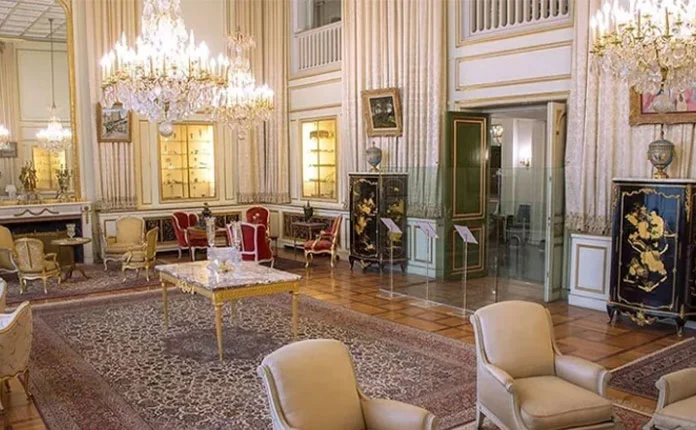
The interior of the ground floor of the main palace welcomes you with a very large foyer. Small mirrors on the wall sit next to each other, creating the illusion of a large mirror with a wind pattern. The unique lighting of the ground floor, reflected in the mirrors, makes the space appear larger and more magnificent.
Throughout the floor, you’ll encounter precious works of art, each surprising in its own way. Here are some of the valuable decorations and paintings featured in Niavaran Palace:
- A collection of porcelain made by the Sur factory in France, adorned with images of Napoleon and the royal family.
- A decorative column symbolizing Saqaqhana by Parviz Tanavoli.
- Silver decorative objects with prominent designs presented by Romania and Nicolae Ceausescu.
- The citadel belonging to Ashraf Pahlavi.
- Still life paintings by Bahman Mohassas and Mohsen Foroughi.
- A carpet with a design depicting the story of Sheikh Sanan and Tersa’s daughter, crafted in the Kerman workshop.
- French bronze and porcelain vases.
- A collection of crystal dishes made in Czechoslovakia.
Reception Room of the Main Palace
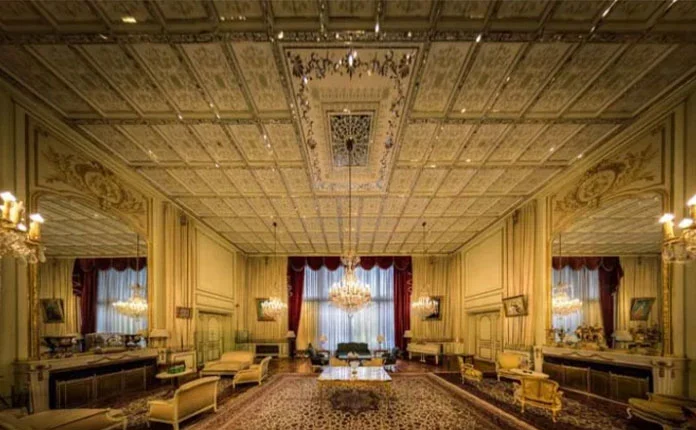
The reception room of the main palace, located on the south side of the ground floor hall, exudes a lively and beautiful atmosphere with large windows and bright color decorations. In the past, this room served as a space to receive court guests, explaining its special decoration filled with precious objects and works of art. Decorations in the reception room include:
- Clay figurines from the pre-Islamic period.
- The painting of three women by Marie Lorensen.
- “The Jungle” by Marvik Kerlamingle.
- Faces of two women by J. Goldern.
- A portrait of Mohammad Reza Pahlavi by him. F. Draper.
- A piano made in Germany, donated by the Ministry of Foreign Affairs of Germany.
- A carpet woven by the Ghaffarian workshop of Isfahan.
- Kashan Lakh Tareng woven carpet with a slim design.
- Bronze of Lorestan from the first millennium BC.
- A carpet woven by the Sedqiani Ahrabi workshop in Tabriz.
Dining Room
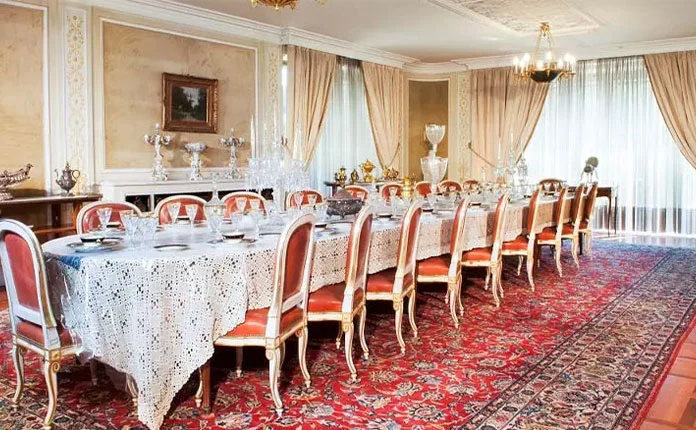
The dining room of Niavaran Palace is not an ordinary space like the other areas. Situated in the southeast side of Niavaran, it is adorned with world-famous custom dining services such as Rosenthal and Bavaria in Germany, Baraka in France, and Moser in Czechoslovakia. This room, where the Pahlavi family and their guests once gathered, echoes with the sound of clattering dishes and lively chatter.
The dining area is also decorated with various precious objects, including candlesticks made by Baraka in France, silver dishes from 19th-century England, gold-plated silver dishes from France, carpets designed by Shah Abbas, and Slimi woven carpets from Isfahan, along with furniture.
Living Room
The living room on the ground floor features different lighting and dark colors in its decoration, creating a unique atmosphere compared to other parts of Niavaran Palace. In this hall, you’ll find valuable objects such as a fox painting by Charles Varela, a Bakhtiari woven carpet with a frame design, a collection of South American civilization pottery, a vase made by the Satsuma factory in Japan dating back to the 19th century, and decorative dishes gifted by Richard Nixon, the former president of the United States.
Exclusive Cinema Hall on the Ground Floor of the Main Palace
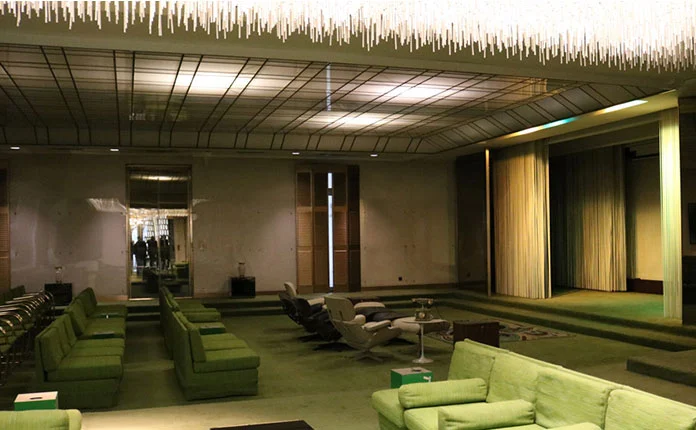
The exclusive cinema of Niavaran Palace, situated on the eastern side, covers an area of about 400 square meters. This spacious cinema features very comfortable seats that make you want to sit and watch movies for hours. The cinema hall includes several main sections, a dressing room, an apparatus room, and a space for controlling and adjusting light, sound, and movie playback.
One of the unique decorations of this hall is the chandelier and the aluminum cinema screen designed by the famous French artist, Charles sevigny. The chandelier, consisting of 4356 handmade glass tubes, used to be lit by 120 moonlight lamps, but now it features LED lamps. Additionally, the cinema rail curtain is made of aluminum, producing a pleasant and miraculous sound when it opens and closes as the aluminum collides with each other.
The Second Floor of Niavaran Palace
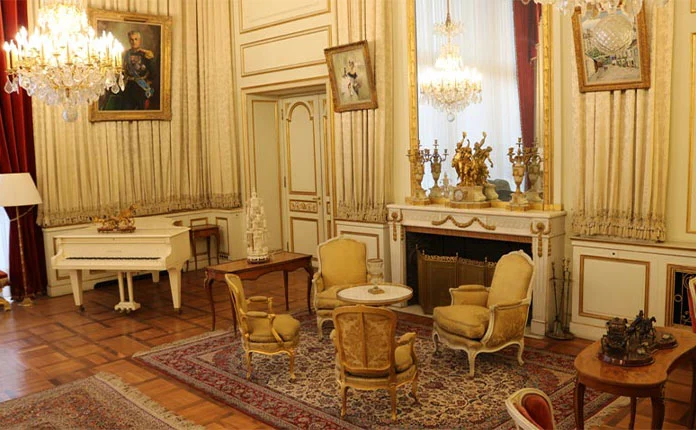
The second floor of Niavaran Palace is dedicated to the private spaces and personal rooms of the Pahlavi family. This floor can be divided into several parts: the outer space of the rooms and corridors, the rooms related to Pahlavi’s children on the north side, and the private rooms related to Mohammad Reza Pahlavi and Farah on the south side.
The outer space of the rooms is adorned with valuable works such as carpets woven by the Sirifian workshop in Isfahan, a picture of Farah Pahlavi by Karim Rouhani, a painting of the river and valley by Hoshang Sihon, a painting of the lapis lazuli beach by Marc Chagall, and several French tapestries.
Alireza Pahlavi’s Room
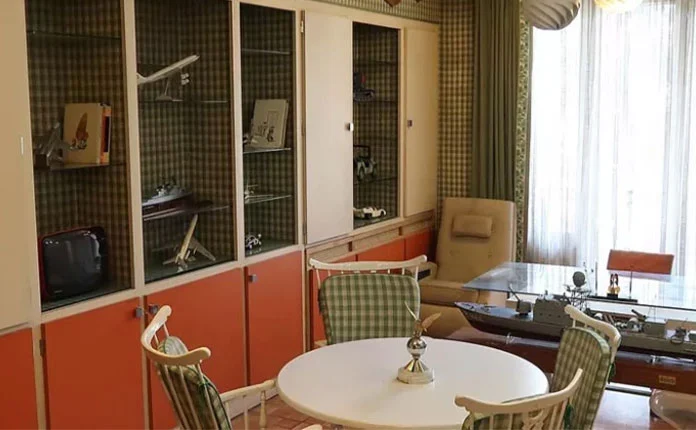
The design of Alireza Pahlavi’s room in Niavaran Palace features blue color, creating an intimate atmosphere. Next to the room is his private bathroom and toilet. In this room, you can find Walt Disney toys and books owned by Alireza Pahlavi.
Alireza Pahlavi’s Study Room
Alireza Pahlavi’s study room, connected to his bedroom, served as a space for his studies. Alireza’s weekly lesson plan can still be seen on the wall, and the room contains various items:
- Qom woven carpet.
- Alireza Pahlavi’s first independent flight commemorative badge.
- Pahlavi II Navy fleet plates collection.
- Model P220 naval ship made in France in 1976.
- Special citadel for Alireza.
Farhanaz Pahlavi’s Room
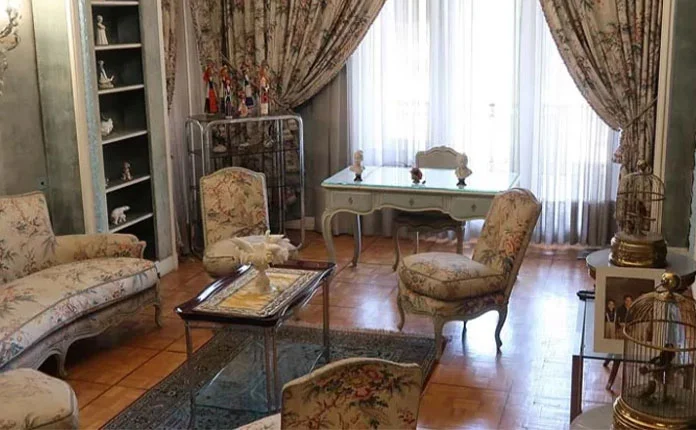
The pink color creates a delicate and girlish atmosphere in Farhanaz Pahlavi’s room, attracting attention at first sight. This room leads to the study room and is decorated with a Tabriz woven carpet and two paintings by Robert Volker and Abbas Katouzian.
Farhanaz Pahlavi’s Study Room
Like Alireza, Farhanaz Pahlavi had a private study room. The decoration of the study room harmonizes with the color and atmosphere of Farhanaz Pahlavi’s bedroom. Additionally, the space on the side of the room served as a place to store Farhanaz’s clothes, some of which are still on display. Among the objects in this room, the following can be mentioned:
- A collection of Chinese sculptures made by Ladro Spain.
- Kashan woven carpet with perangi design.
- Untitled painting by J. Nevert.
- Collection of wooden and fabric dolls made in Russia.
- Decorative cage with taxidermy birds.
- Bronze sculptures by Pierre J.
Mohammad Reza Shah’s Official Clothes Room
In the staircase space of the second floor, a space has been allocated to display the official clothes of Mohammad Reza Shah and Farah. Viewing these clothes will introduce you to the clothing of the court family during the Pahlavi era.
Farah Pahlavi’s Makeup Room and Table
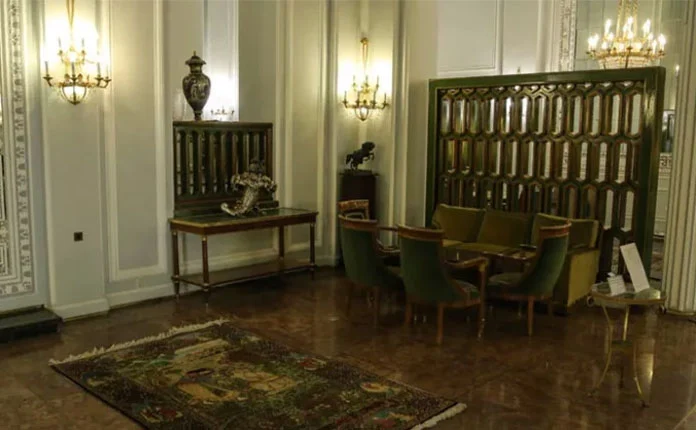
This room was reserved for Farah (Queen) Pahlavi’s makeup. The location of this room provides access to both the bedroom and the entrance hall. Some personal accessories on Farah Pahlavi’s dressing table are still on display.
Resting Room of Mohammad Reza Shah in Niavaran Palace
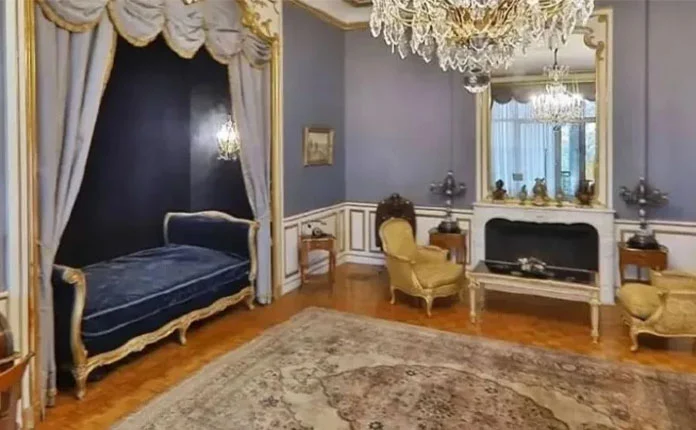
Mohammad Reza Pahlavi’s resting place in Niavaran Palace was a room on the second floor. He usually went to this room for a half-day rest. The resting room of Mohammad Reza Shah in Niavaran Palace is decorated with valuable objects. In this section, we introduce some of these works:
- Writing desk painted on wood made in France in the 18th century.
- Furniture made in France.
- Kerman carpet tapestry with the image of Pahlavi first and his wife Tajul Moluk.
- The painting of two women’s faces by Jean-Marquis Natier, a gift from Senator Mohsen Foroughi on the occasion of the coronation ceremony.
- Gilding and calligraphy in praise of the face of Prophet Muhammad, a gift from Manouchehr Saneyi.
The Roof of Niavaran Palace
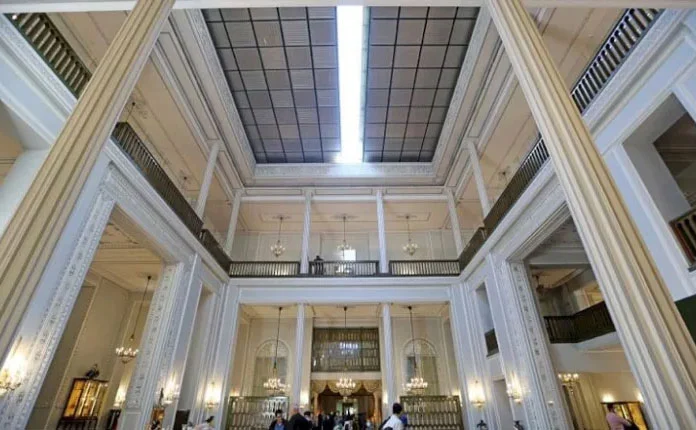
As mentioned earlier, one of the architectural attractions of the main palace is the open ceiling, influencing the overall atmosphere of the palace. When you are on the second floor, you can easily see the ceiling. This movable roof is made of aluminum gables, equipped with a three-phase electromechanical control panel and a phase control system to prevent a two-phase transmission motor system.
When the roof opening button is pressed, the roof moves from the middle to the sides on fixed rails, and it is also possible to stop it at the desired size. The movable roof of Niavaran Palace has been usable since the repairs carried out in 2008 to 2009. However, to prevent damage and ensure controlled use by visitors and enthusiasts, it is opened only on specific days of the year, following a protection schedule based on light conditions, weather, and temperature.
Parts of Niavaran Palace Complex
The historical-cultural complex of Niavaran does not end with the main palace; this historical garden is full of various surprises that can entertain you for hours. In this section, I will introduce you to each of the buildings and museums in Niavaran:
Kushk Ahmadshahi, a Gem in the Garden of Neyavaran
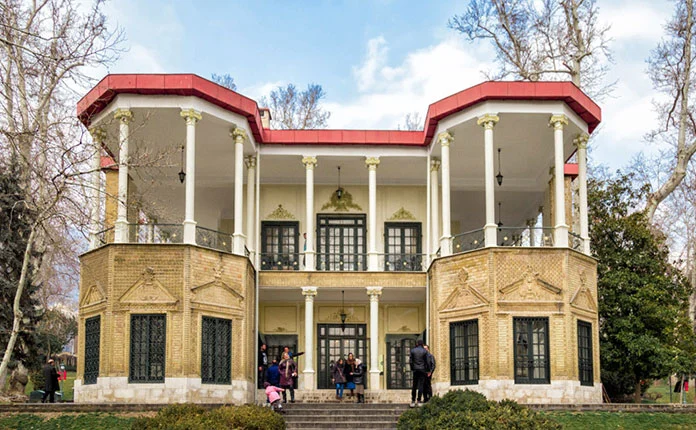
Ahmadshahi Koushak is one of the beautiful buildings of the Niavaran complex, famous for its unique architecture. Unfortunately, there is no information about the construction time of this building, but it is possible that the hut belongs to the Qajar era. The Ahmadshahi hut is built on two floors, showcasing Reza Pahlavi’s place of rest and work.
The exterior of the kiosk is a brick building surrounded by porches with delicate white columns on the second floor. The gable roof of the building was inspired by European neoclassical architecture and the Iranian art of the Qajar era. An interesting aspect of Ahmadshahi Kushk in Niavaran Palace is that the water from the Qanat passes through the fountain in the middle of Kushk, finally reaching the large circular pond in front of the mansion.
The upper floor of the mansion has a main hall, and around it, there is a wide porch used as a music room. Around the hall, there are wooden shelves with showcases. While it is not possible to visit the second floor, all the equipment that was there has been moved to the ground floor, including various musical instruments.
Ahmadshahi Kushk consists of different sections, including a dining room, adjutant’s room, Reza Pahlavi’s bedroom, Reza Pahlavi’s study room, and exhibition space. This mansion, like the rest of the palaces in the Niavaran collection, is full of precious objects and works of art:
- Court piano
- Porcelain vases made by the Qasa’i porcelain factory with the design of Mohammad Reza Pahlavi
- Bow and arrow dating back to 1970 and belonging to the Bear Archer brand
- The book “Girl of the Sea” written by Hans Christian Andersen, translated, and illustrated by Farah Diba
- Commemorative plate of the royal celebration
- French design furniture
- Carved box donated from India
Sahibqaraniyeh Palace, Without Visiting!
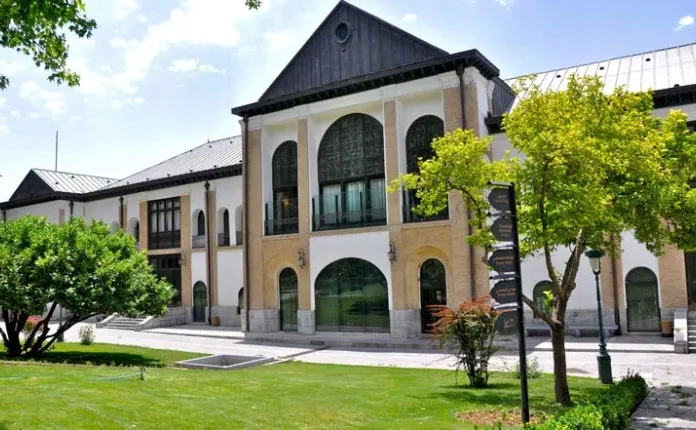
Sahibqaraniyeh Palace is the closest palace that you will see after visiting the Jahannama Museum. This palace was built by the order of Naser al-Din Shah and is considered a relic of the Qajar period.
If you haven’t had the chance to see the interior of Sahibqaraniyeh until today, you probably won’t have this chance until an unknown date! Visiting the Sahibqaraniyeh Palace is currently prohibited.
This palace is made up of different rooms and halls, which have naturally seen different uses over time. One of the spaces of this palace belonged to Naser al-Din Shah’s harem, which Mohammad Reza Shah changed its use and used this place to receive his foreign guests. Of course, it goes without saying that this palace has gone into oblivion to some extent during the time of Reza Shah.
Among the interesting rooms of Sahib Qaraniye Palace, we can mention its dental room. Mohammad Reza Pahlavi decided to build this room in the palace for a checkup and treatment of his teeth.
The appearance of the bathroom and its faucets, all made of bronze in France, speaks for the up-to-dateness of the equipment used in the palace buildings. Of course, in terms of updates, we can mention the use of an ATM in 1353 AH, as well as the use of a computer by Amir Abbas Hoyda, who was one of the first people to use a personal computer in his office.
The Exclusive Library of Niavaran Palace, an Anthology of Culture and Art
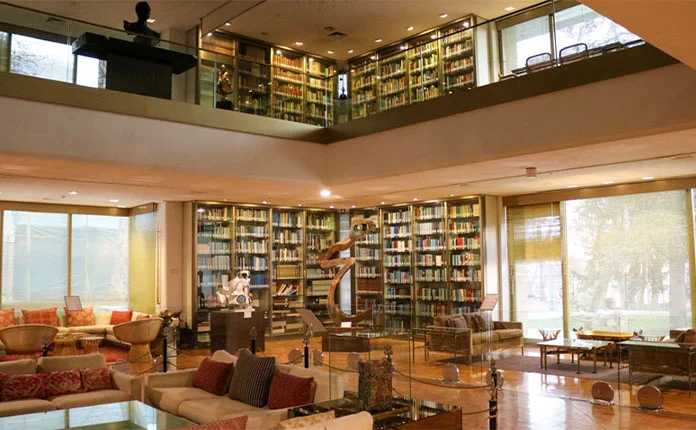
The exclusive library of Niavaran Palace was built in the coziest environment possible, next to the residence of the Pahlavi family. The library is a two-story space with a basement, built as Farah Pahlavi’s exclusive library. The library was designed and built by engineer Abdulaziz Farmanfarmaian, one of the founders of Iran’s new engineering system, and the interior decoration was done by the American artist Charles Svigny.
The interior decoration of the library is a combination of the Iranian space and plan (four porch form), light reflection, and inspiration from the mirror plates. The interior of the library is a combination of glass, mirror, and bronze, giving it a dreamy and calming state. Considering that this library is Farah’s exclusive space, there are many furniture pieces, pianos, audio equipment, and paintings in it, making the space similar to a museum.
The Garden of Inscriptions, the Touch of the Presence of Medians, Parthians, and Sasanians
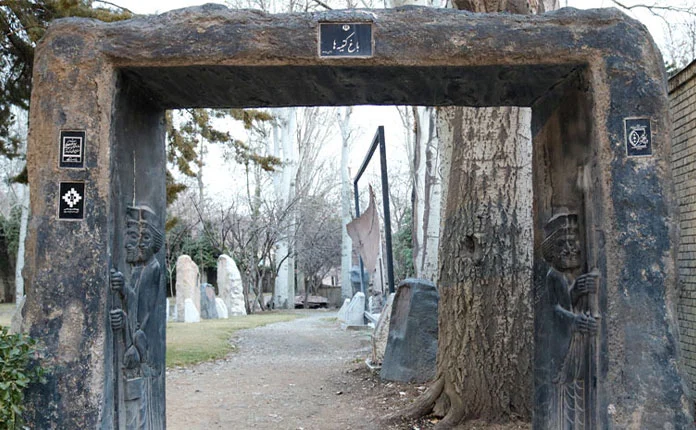
The Garden of Inscriptions in Niavaran Palace is a green space in a corner of the garden dedicated to historical inscriptions. This space was opened in 2008 with the cooperation of the Linguistics Research Institute, Inscriptions and Texts Research Institute of Cultural Heritage and Tourism. The Garden of Inscriptions is a permanent exhibition of the written heritage of human ancestors, including 43 montages of rock inscriptions from different historical periods.
The purpose of building such a museum is to make better use of historical inscriptions and lines for students and researchers. The works in this garden belong to different historical periods such as Medes, Parthians, Sasanians, etc. Urathi, Assyrian, Akkadian, Aramaic, Old Persian, Elamite, and broken Pahlavi script are among the scripts that can be seen on the inscriptions. It is interesting to know that the lines of the Garden of Inscriptions date back to 2300 years BC.
Some of the most important inscriptions of Niavaran historical-cultural complex are:
- Inscription of Shapur and Ardeshir in Rostam Naqsh
- Inscription of Shapur I in the role of Rajab
Dedicated Car Museum
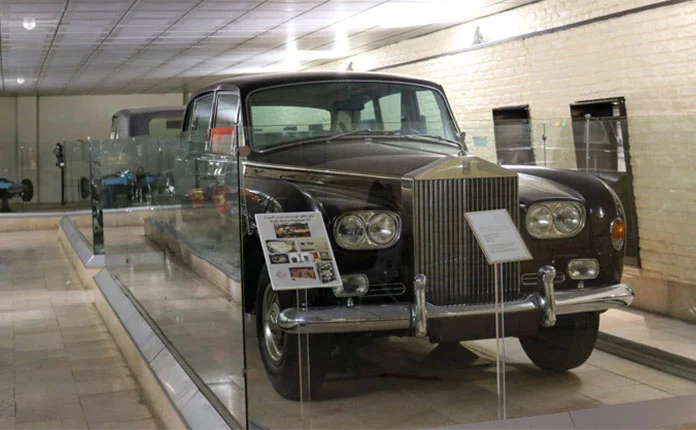
A museum like Niavaran Palace’s exclusive car museum serves as a bridge between the young generation and history, providing an attractive atmosphere for visiting. This building, once used as a car garage, was put into operation in 2013, showcasing works such as exclusive Pahlavi cars, motorcycles of the Pahlavi family’s children, and car replicas.
Among the prominent works of the Pahlavi family car museum, the following can be mentioned:
- Rolls Royce Phantom 1966
- Rolls Royce Phantom 1977
- Honda ATC90 engine
- Honda 50 engine
- CHIBI engine
- Lady Motor
Jahannama Museum, a Reflection of Art and History
Jahannama Museum was established in 1355 AD with the aim of preserving the works donated to the Pahlavi family, especially Farah Diba. To complete the collection of artworks, Farah had experts in charge of buying and collecting the works of great artists. The doors of this museum were opened to the public after the Islamic Revolution in 1376.
The name Jahannama is exactly what you encounter in a museum: a small space that houses a world. The name of this museum is derived from the hall of mirrors of Sahibqraniyeh Palace. The building of this museum includes a ground floor with four halls and a basement with only one main hall. The works in this museum can be divided into two categories: prehistoric art and contemporary visual arts of Iran and the world.
Prehistoric works of art include terracotta vessels from the ancient regions of Iran, works left from the civilization of ancient Egypt, the stone Sardis of Buddha from the 2nd century AD, and the terracotta of culture and civilization of the Andes region. It is interesting to know that some of these works of art date back to 5000 years ago.
